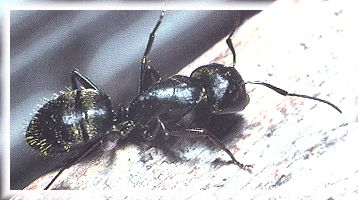Old Rupe is "off his feet" for a while, and we will fill in
for him the best we can. If you are knowledgeable about a particular
insect or local hatch, please help us out - contact:
LadyFisher.
Don't worry about photos, we have good references.

It couldn't have been a picnic - there weren't any ants!
Not likely. Ants are widely distributed nearly everywhere. Like the bees we covered
here last time, ants belong to the order Hymenoptera. And there
are lots of them! No question, trout (and panfish) do eat them.
There is a theory, (is it a theory if it works?) of 'hatch breaking' using an ant pattern
when there is a blanket or heavy hatch of other insects. Toss out a nice fur ant and
watch what happens.
All ants are members of the family Formicidae which is the same
family which wasps belong to. Supposedly ants evolved from wasps - an factor not
overlooked by those who have encountered Harvester and fire ants.
For the fly fisherman's purposes the important ants are a subfamily with about 200
species. The ones fish are most likely to encounter are the carpenter ants, which
excavate their nests in wood and are extremely common in vegetation along trout streams.
Mostly these are large black or brownish in color, some reaching a half-inch in length.
They are found floating or sunken in trout streams.
Colonies of ants swarm, having grown wings for their mating flights. These mating flights
are synchronized with ants from many colonies in the air, and may stretch for 15 miles are more.
Fishing during such a mating flight can be spectacular.
I've known folks who claim to have eaten ants. I'm normally a curious person, but either
I'm not curious enough or haven't been that hungry. Those who have eaten them claim
they taste like dill pickles - ants are loaded with formic acid (hence the name Formicidae
for the order). I don't really need to know what an ant tastes like to tie one or use it.
Summer is prime ant time, and if you don't have an ant pattern or two in your fly box you might
try the pattern in Fly of the Week, or
the Black Fur Ant.
Harrison Steeves in his book Terrestrials talks about
the reason fish seem to love ants claims the answer may be, "Certain pheromones are
secreted when ants lay down a trail for other member of the colony to follow to a food
source. Other pheromones tripper aggressive behavior for protective purposes, and still
others regulated other activities, such as mating." Harrison suggests this very potent
chemical even when diluted in water is what attracts fish. Not the taste of the
insect - the smell!
On the other hand, fish eat what is available. If there are ants, the fish will eat them.
There may not always be a 'hatch' of mayflies, caddis or stones - but in summer and
fall, they probably are ants! Add them to your arsenal. ~ DLB
Credits: Black Ant photo from Terrestrials by Harrison R. Steeves III
and Ed Kock, published by Stackpole Books. We thank Harrison for use
permission.
|



